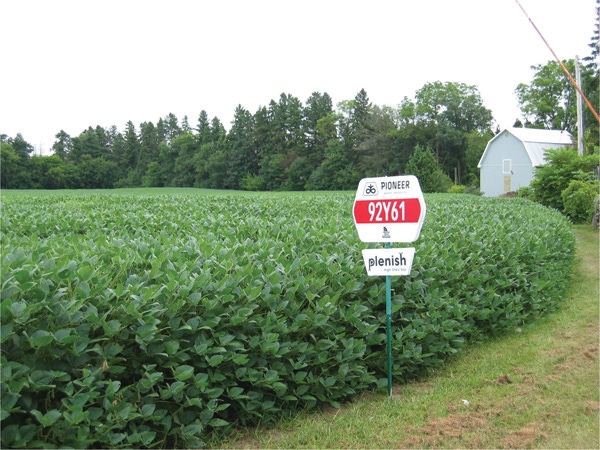March 12, 2013

Getting to the heart of the matter—that is what the United Soybean Board (USB) is doing in forming an industry partnership to develop soybean varieties with healthier oil profiles and healthier market prospects.
Over the next five years, USB is expected to infuse millions of dollars into the rapid market development of high-oleic soybeans. Working with DuPont Pioneer and Monsanto, the USB’s goal is to have high-oleic soybeans available in maturity groups that cover up to 80% of U.S. soybean acres by 2020. Without this new push, high-oleic soybeans might be planted on just 5 to 10% of the soybean acres by that time, USB reports, citing industry projections.
High-oleic benefits
Why are high-oleic soybeans generating this level of interest? Consumer health is one reason. Oil from high-oleic varieties already in the market has zero grams of trans fat and reduced saturated fat, which is of interest to consumers wanting to reduce their risk of heart disease.
Oil from Monsanto’s Vistive Gold low-saturate high-oleic soybeans, for example, has zero grams trans fat and 60% less saturated fat than conventional soybean oil. Oil from DuPont Pioneer’s Plenish soybean varieties also has zero grams trans fat and 20% less saturated fat than commodity soybean oil.
When the FDA mandated trans fat labeling of foods beginning in 2006, the soybean industry began to lose market share to other vegetable oils as food manufacturers began to reduce their use of hydrogenated oil. Half of the soybean oil consumed in the U.S. at that time was hydrogenated, which was great for extending shelf life and improving frying quality, but not so great for human health.
“We lost more than 4 billion pounds of soybean oil in the market to others after the zero trans fat labeling came about. USB’s new partnership is a way to gain back a lot of that market share,” says Jim Stillman, USB chairman and a fourth-generation farmer from Emmetsburg, Iowa.
$8 million in 2013
Hoping that high-oleic soybeans will improve the health of the U.S. soy oil market, USB will contribute $2 million each to the development programs at DuPont Pioneer and Monsanto this year and devote $4 million to market development within the food and farm sectors. Soybean checkoff board members will annually review the project before making additional financial commitments over the next five years, Stillman says.
High-oleic soybeans offer other benefits including increased oxidative stability under high heat use, such as frying. The oil’s performance under high heat also makes it a good candidate for use in the automotive and industrial lubricant industries.
DuPont Pioneer already has high-oleic varieties on the market. For 2013, the company has seven Plenish varieties in the Mid Group II to Mid Group III maturities, including two new T Series varieties available in limited quantities. Plenish regulatory approvals are progressing well. Countries that represent about 96% of U.S. soybean and soybean meal exports now allow the import of Plenish soybeans, oil, and meal for feed and food use.
Monsanto’s Vistive Gold has received approval in the U.S., with global approval for export expected in 2014. At that time, Monsanto will introduce five new varieties.
Monsanto also has formed a partnership with Biosynthetic Technologies to develop biosynthetic lubricant oils from Vistive Gold oils. The new lubricant oils called LubriGreen biosynthetic motor oils are in the final stages of fleet testing and certification. Several major oil companies are using LubriGreen base oils to formulate and commercialize the first bio-based, biosynthetic motor oils.
Because of their different compositions and functionality, high-oleic soybeans will need to be produced under contract and identity preserved, at least in the beginning. To make the extra work attractive to growers, they will receive premiums of $.50/bu. to $1.00/bu. in the initial years of commercialization.
Reducing production costs
“We would like to find ways to produce high-oleic oil without incremental production costs for producers,” says Jim Tobin, grain and crop industry affairs, Monsanto. “We’re all working together to find ways to efficiently produce this oil to compete.” With a number of varieties from which to choose, growers could eventually produce high-oleic soybeans on a significant amount of acres to help make IP simpler and more cost efficient, he adds.
This year, growers will produce DuPont Pioneer’s Plenish soybeans under contract for the Perdue Agribusiness soybean crush facility in Salisbury, Md. These growers will follow a normal IP process, including field identification and record keeping, planter and combine clean-outs between fields, and separate storage units, says John Schartman, senior marketing manager, DuPont Pioneer. Growers will be paid a premium of $.40/bu. for harvest delivery and $.50/bu. for buyer’s call to produce these soybeans.
Traditionally, growers have produced specialty soybeans under contract in Maryland, Ohio and Michigan where grain companies such as Bunge, Cargill and Perdue have crushing facilities and are looking for a consistent source of oil. “We also have a partnership with ADM in Indiana,” Schartman says. The USB’s new effort will provide opportunities for a much larger footprint, he adds.
There are 55 soybean processing facilities across the U.S. in addition to export opportunities, says Russ Sanders, director, DuPont Enhanced Oils Venture. If the USB effort takes off, crushing facilities could be dedicated to handling high-oleic oil. If all of the growers around a facility produced high-oleic soybeans, it would become much more efficient because the costs of special handling would be eliminated, Sanders adds.
The size of the market for high-oleic soybean oil will ultimately be determined by the food and industrial lubricant industries, and it will be price sensitive, Tobin says.
Sanders agrees the market will drive the future of high-oleic soybeans. “But we have a very productive soybean industry and great progress is being made,” he says.
About the Author(s)
You May Also Like




